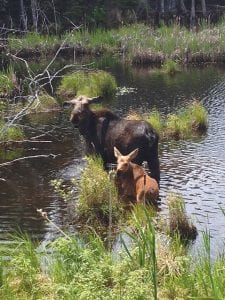Laura Dahl Popkes has been a lucky Gunflint Trail traveler in recent weeks. She was able to get a nice photo of the moose cow and calf hanging out by Swamper Lake and on June 17 she spotted yet another family. This mother and calf were spotted between Poplar and Birch lakes. The duo seems blissfully unaware of the ongoing moose mortality study.

Why are the moose in Minnesota disappearing?
With two-thirds of the herd gone since 2006 when there was an estimated 8,600 in northeastern Minnesota, wildlife scientists are studying a wide variety of causes that could possibly lead to moose mortality. Part of their study was the fitting of 49 moose calves with GPS collars shortly after they were born in hopes of tracking them to see how they fare in the wild. It is a first such study of its kind and the collaring took place May 8-17 in the Arrowhead region.
So far, the calves haven’t done too well.
“Out of the 49, we have 17 left ‘on the air’ with their dams, which we are monitoring,” said Glenn DelGiudice, Ph.D. research scientist, moose project leader for the Minnesota Department of Natural Resources (DNR).
DelGiudice said that three calves were killed by bears, three others were probably taken by wolves, six were definitely taken by wolves, three drowned, and four have slipped their collars. Eight calves were abandoned by their mothers. “We don’t know why,” said DelGiudice, adding, “They might have been young mothers— cows in poor physical condition. Maybe they couldn’t nurse or were ill or maybe they were affected by the collar/capture efforts.”
A normal calf mortality rate is 60 percent, but researchers have noted that in recent years calf mortality rate has grown to 70 to 80 percent in Minnesota—a rate too high to sustain the moose herd.
This calf morbidity study dovetails with a larger ongoing study of GPS-collared adult moose and is also related to several insect studies to help scientists put the pieces of the puzzle together so they can form a picture of what is causing the decline of moose in Minnesota.
Entities assisting the DNR in this wide-ranging hunt for evidence are the U.S. Forest Service, 1854 Treaty Authority, Fond du Lac and Grand Portage bands of Lake Superior Chippewa, and the University of Minnesota College of Veterinary Medicine.
In a related study, Erika Butler, wildlife veterinarian for the DNR, is in charge of a morbidity study of adult moose that were GPS collared in January 2013.
“We’ve had 15 of the 107 (14 percent) of our study animals die so far,” Butler said.
Like the calves, when the moose stop moving for six hours researchers go in to retrieve the animal before it is eaten or degenerates. The carcass is brought back to the lab to see what has caused the animal to perish.
To date, five moose were killed by wolves, two died from a secondary lethal infection caused from wolf attacks, one died from brain worm, three were killed by winter ticks and four results are still pending but are health related.
On June 19 Butler and another team started trapping horseflies/ deerflies. Butler explained, “We are trapping at the Carlos Avery here in Forest Lake. 1854 Authority is running two traps in moose range and the calf crew is manning one trap in the Isabella area.
“The purpose of this project is to hopefully find microfilaria (a juvenile stage of worm) in the [flies] so that we can determine if these tabanids play a role in the transmission of this yet unidentified worm and if so, which species.
“We are also trying to work on a way to determine which species the flies have fed on if there is blood meal present in their abdomen. We are collaborating on this project with the University of Tennessee,” said Butler.
Results from last summer and fall’s mosquito trapping are still pending, said Butler.
Last summer and fall DNR employees trapped 54,319 mosquitos representing 29 species. Those “skeets” were sent to the Minnesota Department of Health for testing to see if they were carrying Eastern Equine Encephalitis (EEE) and West Nile Virus, (WNV) both of which could be deadly to moose.
The mosquito study followed on the heels of the DNR finding EEE after they conducted hunter harvested moose disease surveillance the year before.
“We submitted 129 pools (or groups) of mosquitoes to MDH for testing. Specimens were pooled by species, trap location, and trapping week. Because of the numbers, it took a little longer for them to be sorted so they could be tested,” Butler said.
As far as the adult moose study, Butler said, “The end of the winter was a bit long and drawn out and we have seen a fair amount of adult mortality in this time frame. However, this is expected…. Most moose populations lose the most animals in the spring. The good news is the extended snow cover likely did a number on the winter ticks that were dropping off to lay eggs [if they drop off in the snow, they are more likely to die before they can lay their eggs]. This means there will likely be a lower tick load on the moose next winter.”


Loading Comments